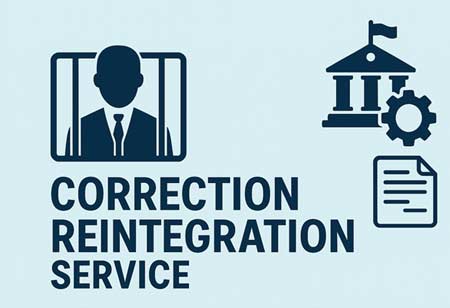THANK YOU FOR SUBSCRIBING
Be first to read the latest tech news, Industry Leader's Insights, and CIO interviews of medium and large enterprises exclusively from Gov CIO Outlook
THANK YOU FOR SUBSCRIBING

By
Government CIO Outlook | Friday, May 30, 2025
Stay ahead of the industry with exclusive feature stories on the top companies, expert insights and the latest news delivered straight to your inbox. Subscribe today.
Correctional reintegration services are driven by a growing understanding of the complexities inherent in supporting individuals transitioning from correctional facilities back into society. The focus is shifting from purely punitive measures to a more holistic, evidence-based approach prioritizing rehabilitation and successful community integration. This evolution is marked by several key trends, innovations, and advancements in community-based support, all underpinned by an increasing reliance on data-driven strategies. Correctional reintegration is a profoundly human endeavor that aims to equip individuals with the necessary tools and support to lead productive, law-abiding lives after incarceration. This involves addressing a wide array of needs, from necessities like housing and employment to more complex issues such as mental health, substance abuse, and social support. The modern approach recognizes that successful reintegration is not a singular event but a continuous process that begins long before release and extends well into community supervision.
Personalized Inmate Programs and Rehabilitation
A prominent trend in the industry's current state is the emphasis on personalized inmate programs and rehabilitation. This signifies a shift away from one-size-fits-all solutions toward interventions tailored to an individual's specific risks, needs, and strengths. Assessments conducted at intake and throughout incarceration are becoming increasingly sophisticated, utilizing comprehensive evaluation tools to identify areas that require targeted support. This personalized approach often includes vocational training, educational programs, and therapeutic interventions designed to foster personal growth and develop practical skills for successful reintegration into society. For instance, programs that offer job skills and certifications are gaining traction, preparing individuals for reentry into the workforce. Integrating such programs within correctional facilities is crucial for developing work skills and qualifications that directly assist in obtaining employment after release.
The Role of Technology in Rehabilitation
Technology integration includes advanced commissary and inmate banking solutions that streamline operations and enhance security. More significantly, technology is being leveraged to support rehabilitation efforts, offering a glimpse into a more efficient and effective future. Digital rehabilitation programs are emerging, providing access to educational content, vocational training, and therapeutic interventions within the prison environment. This digital shift, often utilizing secure tablet solutions or in-cell IP connections, aims to provide inmates with continuous access to rehabilitative services, maintain meaningful family connections, and prepare them for a digitally connected world.
The expansion of community-based correctional support is another critical development. There is growing recognition that effective reintegration extends beyond the walls of the correctional facility. Community-based programs emphasize interventions that leverage support networks and resources available within local communities. This includes housing assistance, transportation, clothing, personal hygiene resources, and direct job placement assistance. The focus is on providing a comprehensive suite of services that support individuals as they navigate the challenges of returning to their communities. These programs often incorporate counselling, skill-building workshops, and restorative justice practices to equip individuals with the tools and support necessary to lead productive and law-abiding lives. The shift towards community-based corrections is seen as a cost-effective and socially responsible alternative to traditional incarceration, helping to alleviate the strain on correctional systems while simultaneously reducing the risk of reoffending. Community organizations play a vital role in this process, providing essential resources and support to individuals as they reintegrate into society.
Evidence-Based Practices (EBPs) and Data-Driven Approaches
EBPs are the cornerstone of effective correctional reintegration services. The industry increasingly relies on research-backed interventions that have demonstrated positive outcomes in reducing recidivism. This includes the widespread application of cognitive-behavioral therapies (CBT), which address distorted thoughts and behaviors contributing to criminality. EBPs extend to every facet of reintegration, from risk and needs assessment to the design and delivery of intervention programs. There is a strong emphasis on continuously evaluating program outcomes, measuring success rates, and cost-effectiveness, as well as identifying areas for improvement. This commitment to Evidence-Based Practices (EBPs) ensures that resources are allocated to proven-effective programs, leading to better outcomes for individuals and enhanced public safety.
Adopting data-driven approaches fundamentally transforms how reintegration services are managed and improved. Data collection, analysis, and interpretation guide the sector's decision-making processes. This involves utilizing risk assessment tools, such as the Correctional Offender Management Profiling for Alternative Sanctions (COMPAS) and the Level of Service Inventory-Revised (LSI-R), to assess the likelihood of reoffending and inform treatment and supervision plans. Data is also instrumental in resource allocation, directing efforts to areas with the greatest need, such as high-risk individuals or overcrowded facilities. Furthermore, robust data systems are utilized to evaluate the effectiveness of rehabilitation and intervention programs, enabling agencies to track outcomes, assess cost-effectiveness, and pinpoint areas for improvement. Policymakers are using data to identify patterns of criminal behavior and recidivism, develop evidence-based policies, and evaluate the effectiveness of new initiatives. This analytical rigor fosters a continuous improvement cycle, ensuring that reintegration efforts are optimized for maximum effect.
A progressive evolution characterizes the correction reintegration service industry. The prevailing trends point towards individualized, technologically enhanced, and community-centric approaches, all informed by rigorous data analysis and evidence-based practices. This comprehensive strategy aims to facilitate successful transitions for individuals re-entering society, contributing to safer communities and a more just society. The continued investment in these areas signifies a sector committed to long-term positive change and effective public safety outcomes. Policymakers play a crucial role in shaping the future of correctional reintegration services, and their decisions can significantly impact the effectiveness and reach of these services.
I agree We use cookies on this website to enhance your user experience. By clicking any link on this page you are giving your consent for us to set cookies. More info

However, if you would like to share the information in this article, you may use the link below:
www.govciooutlookapac.com/news/the-future-of-correctional-reintegration-services-nid-2458.html



